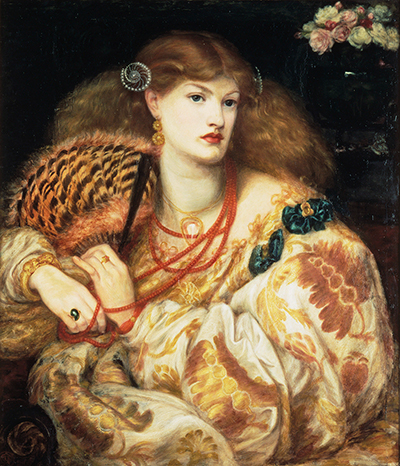Monna Vanna, painted in 1866 by Dante Gabriel Rossetti, is an oil-on-canvas portrait of a red-haired woman who is holding a feather fan while wearing an embroidered gown of white and gold. Alexa Wilding, one of Rossetti’s favourite models, sat for the painting and the English artist portrayed her as one of the Venetian beauties that were painted by Titian as well as by other masters of the Renaissance period.
Rossetti, aware of the political situation in Europe, chose a Venetian theme at a time in which the city was leaving the Austrian Empire and joining the unified Italian state. The portrait, retouched in 1873 and renamed on several occasions, measures 889mm by 864mm and is displayed at the Tate Britain art museum in London. Rossetti, who was descended from Italian nobility, sought to emulate the artistic styles of the Late Gothic and Renaissance periods that dominated the cultural landscape of Southern Europe in the 15th century.
This painting, completed four years after the death of his wife Elizabeth Siddall, is typical of the female portraits that were created in the 1860s and which marked a change from the group-orientated and medieval-themed artworks of previous decades. These intimate portraits, beginning with Bocca Baciata in 1859, focused more on the realism of their subjects and less on the moral and symbolic themes of earlier paintings. Wilding’s striking pose, however, could be interpreted as a study of the arrogance and vanity of a beautiful noblewoman who was born into power and privilege.
Wilding, her head turned to the right of the canvas, reveals an earring with two golden flowers that hangs from her left earlobe while her hair is held back by two pearl-studded hair clips that are shaped like the spiral of a snail shell. A gold bracelet, a symbol of wealth and status in Venice, is worn on the model’s left wrist and resembles a double-headed serpent. Both of her rings, one worn on each hand, are inlaid with a gemstone. The model is unsmiling and her piercing blue eyes stare into the distance, avoiding the viewer’s gaze, while her eyebrows are raised into arches. A vase of pink, red and white flowers rests on a shelf behind the model’s right shoulder and stands in contrast to the dark background.




